So, you are planning your surgery. You have your reservations, your tickets, your suitcase, etc, etc. But what about when you get home? This information was gathered primarily to help get you through the rough times after surgery. What you are going through will not be easy, but you have made it this far, and we hope to help make the rest of your journey a little easier.
One of the first things you should do is get your yellow pages and locate a surgical supply store near you (Look under the Surgical or Pharmacy headings). They will stock many of the items you will need, including some that may be difficult to find anywhere else, and often at prices lower than your local drug store.
You are going to need quite a few thin Maxi Pads and panty liners. You will need the thin Maxis for about 4 weeks after surgery, and you may be able to switch to panty liners after that time. You will need to change the pad after each dilation and before you go to bed, so plan on a minimum of 6 pads per day. It is a good idea to stock up during sales in the months prior to your surgery. One brand that many women have expressed a preference for is Always®. The covering tends to stick to the incisions less than some other brands do.
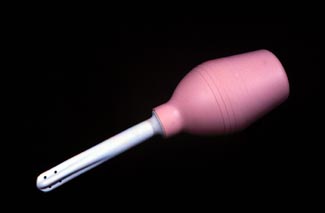
For immediate use following surgery, it's easier to purchase and use the disposable douche applicators of the type recommended by your surgeon (usually vinegar and water, or Betadine). After surgery, these can get expensive, so the best alternative is to purchase a bulb type douche, consisting of a rubber or soft plastic squeeze bulb and a removable pipe, and make your own vinegar and water solution (one tablespoon of white vinegar per quart of water). If you prefer Betadine douche, mix one teaspoon of Betadine in 6 ounces of water.

You may wish to purchase one or two packages of pre-moistened personal wipes, such as "Scott Fresh" or "Kleenex Cottonelle®". These provide effective yet gentle cleansing of the surgical site, and with a little Betadine also provide disinfecting of the surgical and anal area after a bowel movement. One alternative is pre-moistened Baby wipes, but many, if not all, of the baby wipes have "Do Not Flush" printed on the container.
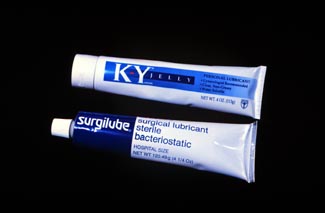
For dilation, you are going to need a large quantity of lubricant, such as KY Jelly®. Surgilube®, a sterile lubricant, is available at the Surgical Supply store for about one-third of the cost of KY. You may be able to cooperate with several friends and purchase larger quantities, such as a full case at a substantial discount. Plan on having a minimum of 24 tubes (two boxes) before you leave for surgery. Do not use liquid lubricants such as Astroglide for three months. Some surgeons are reporting that they interfere with proper healing of the vaginal lining.
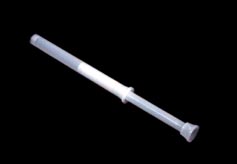
During dilation, simply applying the lubricant to the dilator and then inserting it often does not provide adequate internal lubrication, which can lead to excessive pain and irritation. One solution to this problem is to use the applicator that is supplied with product such as Gyne-Moistrin® (a vaginal moisturizing jelly) or other lubricant or spermicidal product that provides a re-usable vaginal applicator.
You are going to be doing a lot of cleaning and wiping during your recovery, especially after dilating. While paper towels and toilet paper will work, they will leave a lot of paper residue behind. As an alternative, you may wish to purchase about 2 dozen cotton washcloths, provided that you have the facilities to launder them at home. You are also going to need several towels or waterproof pads to place under you while dilating.
You should have a bottle of 400 IU Vitamin E capsules. Medical studies have shown that the application of Vitamin E to wounds or incisions increases the healing rate and reduces the amount of scar tissue formation. Keep in mind that this is very dependent on you, as not all people respond the same to this treatment. To apply, wash your hands and puncture the capsule with a sterile needle or knife. Squeeze the contents onto your finger(s) and apply to the external incisions. Repeat the application after washing the area. Do Not apply to the interior of the vagina. Some lotions are advertised as containing vitamin E, but they contain very little actual vitamin E, and may contain ingredients you neither want nor need.
Your surgeon may recommend that you use Bacitracin® or Neomycin®, also sold as Triple Antibiotic ointment under store names. Some brands are available with Lidocaine, a topical anesthetic. Apply it along with the Vitamin E.
Please make sure that you have your soon-to-be constant companion, the inflatable rubber doughnut (really, it's called an invalid ring). You can put it in a pillowcase if you wish.
For good healing and recovery, you are going to need good nutrition. You are not going to feel like doing much cooking for several weeks, so if you are living by yourself, stock up with nutritious foods that are easy to prepare, such as soup, or prepare dinners before you leave and freeze them.
Post-Surgical Responses
After you return home, it is important that you get all the rest that your body requires as it diverts energy to the healing process. Listen to your body. If you feel tired, take a nap. Don't push yourself and don't even think about resuming your normal workload. Heavy Lifting is right out! Failure to heed these warnings can adversely affect your healing, and therefore the overall results of the surgery. Take six weeks to recover if you can, but don't take less than four.
After two or three weeks, you will probably feel your strength starting to return and be tempted to resume some of your normal activities. For example, you may feel strong enough to go shopping at the mall only to find yourself totally exhausted after 30 minutes.
Although every person will respond and heal at different rates following surgery, there are many physical responses that are quite common. For example, you will experience some degree of bruising and discoloration around the surgical area. This may range from a few small bruises on the thighs and buttocks, to extensive bruising from the navel down. One woman, upon observing the degree of bruising, asked her surgeon if his assistant had been beating her with a stick while he worked. Most of the discoloration will fade in a short time, but some may remain for several weeks.
General swelling of the entire surgical site is a typical response, and this will usually last longer than the discoloration. It may take 6 weeks or even longer in some cases for all of the swelling to completely subside.
If you experience an increase in localized swelling, especially along a suture line combined with localized pain, redness, warmth, or a discharge from a suture line, seek medical help immediately.
Some women experience a minor problem with a few sutures in the labia that do not dissolve by themselves. Your local doctor should remove any labial sutures that have not dissolved after three weeks.
Another problem may occur with sutures that dissolve too early. This usually occurs in the area between the vagina and the anus and results in the incision opening slightly. Keep it clean and covered with antibiotic ointment, and it should heal by itself.
One of the results of the swelling is that you may not be able to urinate in a stream until the swelling subsides. The result is that you may "spray" urine in a variety of directions, including all over yourself. Messy, but not harmful. As the swelling subsides this problem will usually disappear.
Everyone has a different tolerance to pain, so we cannot tell you how much pain you will experience. Over-the-counter analgesics will usually handle the pain, but if you feel that the pain is severe, contact your doctor. You will probably find that the pain is least severe when you are lying down, so go with the feeling. During the early phases of your recovery, you will find that changing position from lying down to standing up will cause a sharp increase in pain in the surgical area. This is caused by blood accumulating in the lower part of your body due to gravity. This sensation will decrease as healing progresses
You should expect a variety of fluid discharges during the first few weeks of recovery. You will see small amounts of blood and plasma (a clear yellowish fluid) on your pads. These discharges will decrease as you heal. If you experience continued bleeding in small amounts (heavily stained pads) for more than 2 weeks, or if you experience a large amount of bleeding, seek medical help immediately.
Another discharge that is quite common is dead tissue from various areas in the surgical site. When the surgeon rearranges the tissues, some parts, such as a piece of skin or other tissue, no longer have any use in its new position, and your body will gradually remove it. This process is called "sloughing". The sloughed tissues will show up as small clumps or spots of white or whitish-yellow mushy stuff, both externally and from within the vagina. The amount depends on you and the surgical technique, and will vary from a very tiny amount to very large clumps in some cases. This will typically last two to three weeks. If you experience any signs of infection (localized swelling, pain, redness, and/or warmth), or you notice a foul odor, seek medical help immediately.
If you have ever experienced hemorrhoids, surgery and subsequent dilation may cause them to flare up. Not everyone will suffer this problem, but you should be aware that it could happen. Over the counter preparations may help alleviate the symptoms, but prescription strength products may be preferable if the hemorrhoids cause dilating to be more difficult. Consult your regular doctor if this should occur.
Due to the nature of the surgery, it is unavoidable that some nerves will be injured or severed. This can lead to areas of numbness and/or tingling in and around the surgical site. The vast majority of these areas will regain normal feeling as the nerves regrow, but the process may take up to a year, so don't panic.
An interesting little side effect of the healing process is the occurrence of "electrical shocks" in the surgical area. These are caused by the regrowth of the nerves in the area, and it does indeed feel like a rather sharp electrical shock. They can feel strong enough to make you jump, and while they can be uncomfortable, they are harmless and should decrease over several weeks.
Another thing about nerves is the occurrence of "phantom pain" or "phantom itches". Your brain has built a three dimensional "map" of the nerve endings throughout your body. For example, a nerve ending located 5 feet 8 inches down and 8 inches in front of your brain, and on the right side, is in the area corresponding to your right toes. So if you drop something on your foot, your brain gets the signal from the nerve endings, looks up the location in its map, and tells the conscious part of your brain that your foot needs attention.
During surgery, tissue with its associated nerve endings gets moved around quite considerably. Because your brain has not had sufficient time to update its map, it may be telling you that you are experiencing an excruciating itch somewhere in your groin, when in fact that particular nerve ending is now deep inside you. You may automatically reach for the spot and be surprised when you find that you can't scratch it. This will disappear quickly as your brain adjusts.
You will be experiencing a sudden change in hormone levels, and for some individuals this can result in sudden and unpredictable mood swings and/or feelings of depression. You may find yourself suddenly crying uncontrollably for no apparent reason. This is usually temporary and should resolve itself when you start taking hormones again. If these feelings seem overwhelming, contact your doctor about your hormones.
Hygiene
Good hygiene is critical to successful recovery. This means keeping the surgical site absolutely clean. This is critically important after a bowel movement. Always wipe yourself from front to back! A baby wipe will probably be more comfortable and provide more thorough cleansing than toilet paper. After the area has been thoroughly cleansed, apply Betadine® to another baby wipe and wipe the entire area, starting with the surgical site. Remember, always wipe from front to back to avoid contaminating the surgical site. Thorough cleansing after dilating is also important. After cleansing, apply the Vitamin E and antibiotic ointment.
If your surgeon does not recommend the use of Betadine®, but he does not recommend against it, we would advise you to purchase and use the Betadine®. It is a powerful disinfectant, and we feel it is better to be over-enthusiastic when cleansing, than take chances with developing an infection.
Dilating
Now we get to the part that seems to worry everyone the most: the dreaded dilation. Let's be honest here. It is time consuming, generally uncomfortable, and sometimes painful. But next to hygiene, it is the single most important thing you can do to insure the success of your surgery. Failure to dilate properly can result in serious injury, or failure to achieve adequate depth and width of the vagina.
Now that you are properly frightened, let me reassure you that with a little guidance from us and some dedication on your part, you can get through this.
Follow your surgeon's instructions regarding the frequency of dilation. The goal is to be able to reach full vaginal depth (this varies according to the individual) without excessive discomfort. As you progress you will be able to judge for yourself when you can reduce the number of daily sessions. Remember, it's better to dilate more frequently than less.
First, gather all of your materials together. You will need your dilators, lubricant jelly, waterproof pad or towel, and a small towel or washcloth. Wash your hands thoroughly Place your pad or towel on the bed, lie down and get comfortable. Sometimes, a small pillow under your hips will help. You want to be able to relax, especially the muscles in the groin and lower abdomen. Relaxing music can be helpful, as can meditation.

You need to be as relaxed as possible to minimize discomfort. A common mistake is to spread your knees as wide as possible. This actually makes insertion more difficult because it tenses the muscles in the thighs and lower abdomen.

Place your feet about the width of your hips apart and bend your knees at about a 45 degree angle. Move your knees apart only enough to get your hand between them.
If you have trouble reaching your vagina, do not pull yourself up with your abdominal muscles. Instead, place pillows behind your shoulders and neck for support.
Now lubricate the dilator you will be starting with. However, when inserting the dilator, much of the lubricant will be scraped off of the dilator as it passes through the vaginal opening. Therefore it is useful to insert some of the lubricant into the vagina prior to inserting the dilator. The lubricant can be applied by finger, or by means of an applicator such as the applicator supplied with product such as Gyne-Moistrin (a vaginal moisturizing jelly) or other lubricant or spermicidal product that provides a re-usable vaginal applicator. Fill the applicator with lubricant (KY or Surgilube), insert the applicator into the vagina, and push the plunger to place the lubricant into the vagina. This will provide extremely good lubrication exactly where you need it. Relax and open your legs to a comfortable position. Insert the nose of the dilator into the vaginal opening. The dilator must be inserted at the proper angle to avoid damaging the vaginal wall.
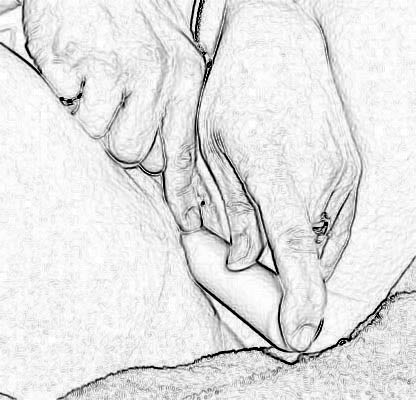
NEVER insert the dilator at a downward angle.
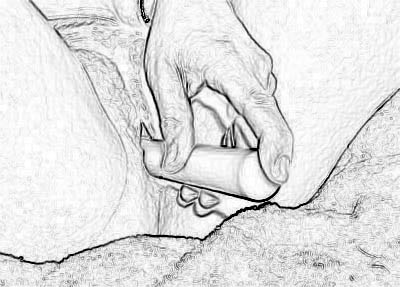
Always insert at a flat or slightly upward angle, as if pointing toward the navel.
It may be necessary to put your thumb or finger on the top of the dilator shaft and apply slight pressure so that the nose of the dilator passes under the pubic bone.
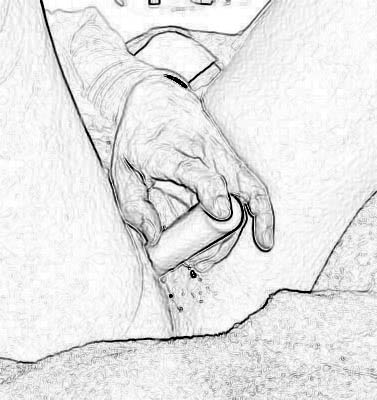
Never insert the dilator at a downward angle to get it under the pubic bone!
If you are using straight dilators, begin rotating the dilator back and forth about a quarter to a half turn in each direction while applying gentle pressure to ease the dilator into the vagina. Alternatively, you can rotate the dilator in one direction while applying pressure. The rotation will make insertion easier. As the dilator enters the vagina, you may feel the dilator become more difficult to insert or rotate. You are either not far enough below the pubic bone or you are encountering the PC muscle. When the surgeon created the vaginal cavity, he had to make an opening in this muscle for the vagina to pass through. This muscle is not used to having anything poked at or through it, and it may start spasming or cramping. This makes it feel like you can not get the dilator in. Relaxation will help a lot, but you may want to try massaging the PC muscle to help it relax. Reach into your vagina with a clean finger and locate the area where it feels like the dilator stopped. Gently massage the surrounding tissues and try the dilator again. The PC muscle will quickly be "trained" to accept this, and should stop giving you problems relatively quickly. Continue rotating and insert the dilator again, until full vaginal depth is reached. Although the sensation is difficult to describe, you will be able to feel when you have reached full depth. Once at full vaginal depth, continue rotating the dilator and apply gentle inward pressure. The slight friction as the dilator rotates will help stretch the tissues. If rotation becomes difficult, remove the dilator and apply additional lubricant to the nose of the dilator, or use the applicator to apply additional lubrication internally.

Once the dilator is inserted, relax your legs by bringing your knees together and straightening them as much as you can. You may roll over on your side with your knees slightly bent if you wish.
An accurate measurement of vaginal depth can be made immediately following dilation. Remove the dilator and wipe off any remaining lubricant. Insert the dilator to full vaginal depth and rotate it in one direction for 3 or 4 turns. There will be adequate lubricant remaining in the vagina for this. Remove the dilator and measure the part of the dilator that is covered by the lubricant.
After dilating, thoroughly clean the area as described previously. Clean the dilators and applicator with antibacterial dishwashing liquid and water. To relieve post-dilating discomfort, try a warm bath, or apply moist heat to your groin.
One problem that many people encounter is how to maintain the required dilating frequency when they return to work. Some people have made arrangements to use the Infirmary. Others have successfully dilated in a stall in the lady's room. This is a situation that you will have to explore for yourself before surgery, and depends upon your work situation.
Sexual Response
This is an area that is very dependent on you, and all we can do is provide some information about what has happened to others. Some people recover sensation quickly, for others, the process can take many months. The best thing to do is to wait, and not worry about it. When it happens, you will know.
One thing that people worry about is whether or not they will have self-lubrication. The surgeons that we know of will tell you that there will be very little, and for some people, this is true. On the other hand, others find that they can produce adequate lubrication for intercourse. The lubrication reportedly comes from two sources: The urethra and the vagina. The urethral secretions probably originate from the remaining glands such as the cowpers gland and the prostate gland. The origin of the vaginal secretions is more of a mystery, but it has been reported. The only way you will find out is to wait and see how you respond. Remember that there are no guarantees about this.
Some of the surgeons have been using a section of urethral tissue as a way to provide additional lubrication. The urethral tissue is mucousal in nature, and will continue to secrete mucous and provide lubrication.
Whether or not they will regain orgasmic function is an important question for many people. As with lubrication, this is very dependent on you, and there are no guarantees. It does happen for many people, so keep a positive attitude and after you are healed, start experimenting. Things are different now and you will have to learn some new tricks, but during the learning process, the practice can be so much fun.
For men, orgasm — usually occurring fairly quickly — is almost a sure thing whenever sexual stimulation is undertaken. For a woman, this may not always happen so it may be more effective to approach the session with the idea that you simply want to experience pleasure without specifically seeking orgasm. Holding out orgasm as the specific goal may create a sort of performance anxiety that leads to further frustration and a cycle of failure.
The physical surroundings may be rather unimportant to men, but for many women it is extremely helpful to find a quiet and relaxing place where you won't be disturbed. "Getting in the mood" with sensual things like music, soft fabrics, a warm bath, muted lighting, etc., can be beneficial. Some discover a heightened sensitivity to fragrances and tactile stimuli like the gentle breeze from a ceiling fan. Anecdotally, it has been suggested that men tend to have a more strongly visual/cognitive component to sexual arousal, while women may find tactile and olfactory stimuli more persuasive.
In your former life, you may have been accustomed to very focal stimulation but now you may want to get your whole body more involved in the process, breasts, abdomen, legs, face, everything.
Some have suggested there is an erotic component to feminization and feminization fantasies that may dissipate for a while or even permanently after vaginoplasty. The extent to which this phenomenon may occur is obviously variable. In some instances, however, an individual may find that her old core fantasies need to be redeveloped, replaced or just discarded.
Genital surgery remaps tissue and nerves, so take some time to gently but thoroughly explore your anatomy. There might be all kinds of stuff going on there you didn't expect.
Another factor in sexual function is your endocrine system. A proper hormone balance is often critical to proper sexual functioning. Both women and men require testosterone for libido and orgasmic ability. After surgery, some women find that their adrenal glands (the other source of testosterone) do not produce enough to provide adequate libido or orgasm. You may require a small amount of supple mental testosterone to regain functioning. The amount required is typically far below the amount that will cause any other unwanted side effects, such as hair growth. Not everyone requires this, but keep in mind that some do.
It is important to be patient and learn about your new body in a playful and joyous way. Don't put expectations on yourself — just revel in who you are. Take your time, and let every part of your body and your mind and your spirit have a role in the experience. Give yourself the freedom to truly love yourself and appreciate your own beauty and unique sensuality. Crummy sex is probably worse than none at all, but good sex, well...
Copyright 2000, Intelligence Engineering, LLC
Comments
comments powered by Disqus